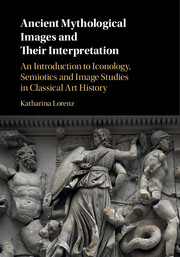 Ancient Mythological Images and their Interpretation
Ancient Mythological Images and their Interpretation 3 - Narratives of object and meaning
from ICONOLOGY
Published online by Cambridge University Press: 05 August 2016
Summary
Iconology as experiment: the results
Iconology is concerned with the picture as a thing. The method as applied here, based on the Panofskyan model, focuses the interpreter on the depiction and its artistic background. The objective is to synthesise as historical evidence the individual elements that shape the picture. In praxi, as the case studies demonstrate, the interpretive framework of iconology allows for a range of questions, their substance dependent on the character of the picture under scrutiny.
At the pre-iconographic stage iconology is concerned with translating the elements constituting the visual into the verbal. This process results in a detailed report on the characters, their attire, and their relation to each other and to other pictorial elements that otherwise might easily be overlooked – but without qualitative judgement. Such an exercise in structured viewing is devised in order to avoid the pitfalls of the associative-philological and the generalising approaches frequently found in the study of Greek and Roman representations of myth. It ensures a focus on the depiction alone, setting to one side what one would expect the picture to represent on the basis of textual versions of the myth.
A significant problem arises here, for structured viewing does not translate well into written argument. If an exercise in structured viewing is presented prior to iconographic assessment, redundant data, perhaps in significant quantity, might be put in front of the reader. The present study therefore amalgamates the pre-iconographic and iconographic stage. But does then the associative-philological approach appear to prevail, with the decision to focus on Paris, Zeus and Athena, and Meleager in the three case studies apparently driven by knowledge of the myth and pre-existing assumptions about how the picture might emulate that myth?
The case studies are revealing at the iconographic stage the potential existence of correctives that will enable us to avoid slipping back into the vicious circle of the associative-philological approach, which comes with the threat of tautology. These correctives are provided by other materials that are to be compared with the picture under scrutiny, making up for the fact that when faced with a narrative picture, iconology presupposes a narrative, but without investigating either its actual formation within the picture – as happens in semiotics – or how that narrative might be shaped by the picture's materiality, its shape, location, and function – as happens in image studies.
- Type
- Chapter
- Information
- Ancient Mythological Images and their InterpretationAn Introduction to Iconology, Semiotics and Image Studies in Classical Art History, pp. 89 - 100Publisher: Cambridge University PressPrint publication year: 2016
